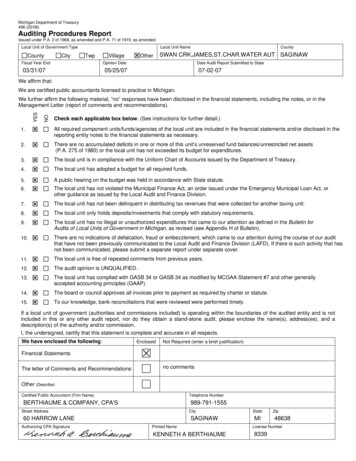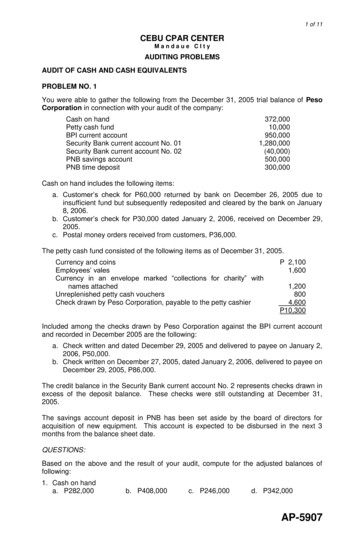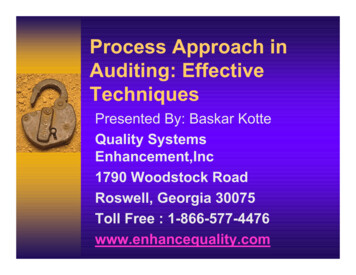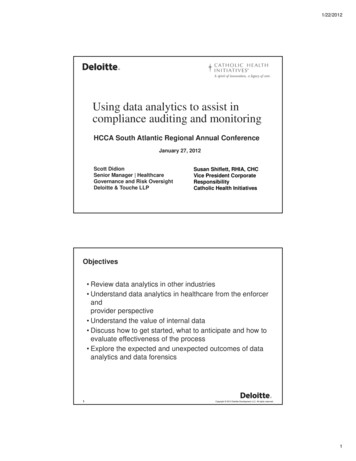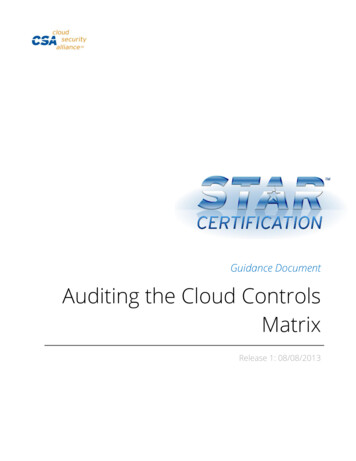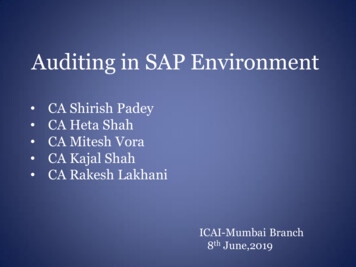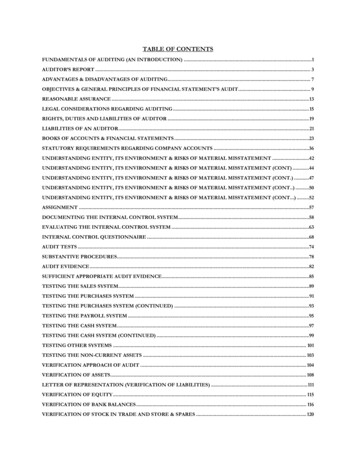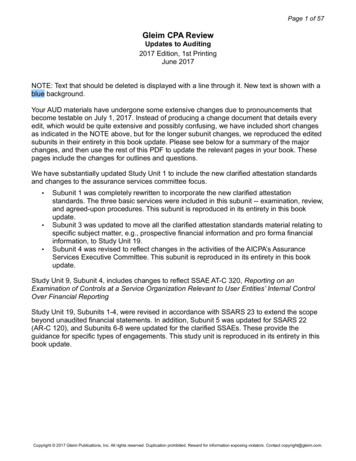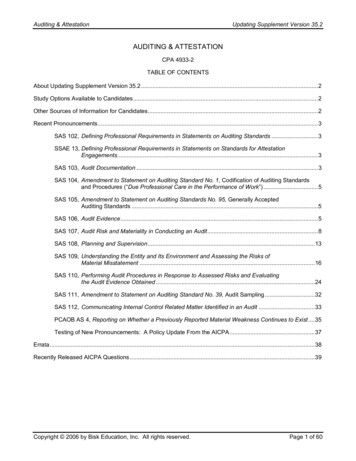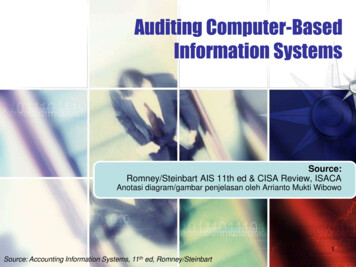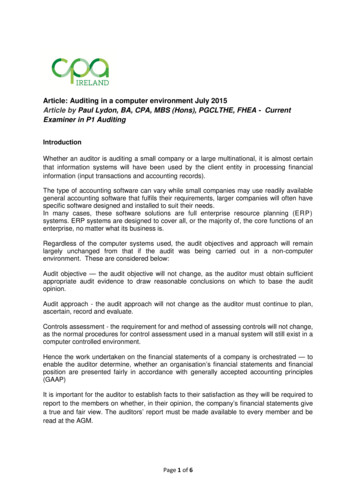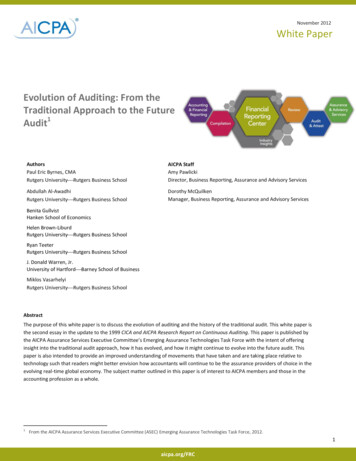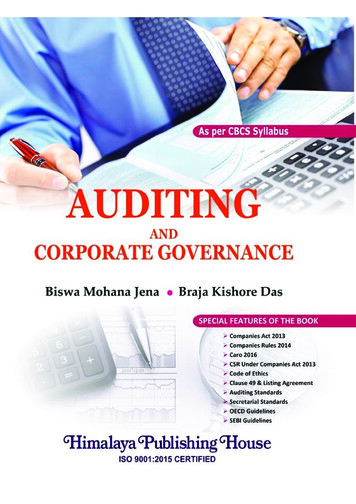
Transcription
AUDITINGANDCORPORATE GOVERNANCE[As per New CBCS Syllabus, w.e.f. 2018-19]Dr. Biswa Mohana JenaDr. Braja Kishore DasM.Com., M.Phil., Ph.D.M.Com., M.Phil., Ph.D., UGC-NETHead, Department of Commerce & Economics,Netaji Subhas Chandra Bose(Govt. Lead) College,Sambhalpur, Odisha.Senior Faculty in Commerce,Nimapara Autonomous College,Nimapara, Odisha.ISO 9001:2015 CERTIFIED
AUTHORSNo part of this publication may be reproduced, stored in a retrieval system, or transmitted in any form or by anymeans, electronic, mechanical, photocopying, recording and/or otherwise without the prior written permission of theauthors and publisher.First Edition : 2019Published by:Branch Offices:Mrs. Meena Pandey for Himalaya Publishing House Pvt. Ltd.,Ramdoot, Dr. Bhalerao Marg, Girgaon, Mumbai - 400 004Phone: 022-23860170/23863863; Fax: 022-23877178E-mail: himpub@vsnl.com; Website: www.himpub.comNew Delhi:Pooja Apartments, 4-B, Murari Lal Street, Ansari Road, Darya Ganj,New Delhi - 110 002. Phone: 011-23270392, 23278631; Fax: Kundanlal Chandak Industrial Estate, Ghat Road, Nagpur - 440 018.Phone: 0712-2738731, 3296733; Telefax: 0712-2721216Plot No. 91-33, 2nd Main Road, Seshadripuram, Behind Nataraja Theatre,Bengaluru - 560 020. Phone: 080-41138821;Mobile: 09379847017, 09379847005No. 3-4-184, Lingampally, Besides Raghavendra Swamy Matham, Kachiguda,Hyderabad - 500 027. Phone: 040-27560041, 27550139New No. 48/2, Old No. 28/2, Ground Floor, Sarangapani Street, T. Nagar,Chennai-600 012. Mobile: 09380460419First Floor, Laksha Apartment, No. 527, Mehunpura, Shaniwarpeth(Near Prabhat Theatre), Pune - 411 030. Phone: 020-24496323, 24496333;Mobile: 09370579333House No. 731, Shekhupura Colony, Near B.D. Convent School, Aliganj,Lucknow - 226 022. Phone: 0522-4012353; Mobile: 09307501549114, SHAIL, 1st Floor, Opp. Madhu Sudan House, C.G. Road, Navrang Pura,Ahmedabad - 380 009. Phone: 079-26560126; Mobile: 0937708884739/176 (New No. 60/251), 1st Floor, Karikkamuri Road, Ernakulam,Kochi - 682011. Phone: 0484-2378012, 2378016; Mobile: 09387122121Plot No. 214/1342, Budheswari Colony, Behind Durga Mandap,Bhubaneswar - 751 006. Phone: 0674-2575129; Mobile: 09338746007108/4, Beliaghata Main Road, Near ID Hospital, Opp. SBI Bank, Kolkata - 700 010,::Rachi Enterprises, BangaloreInfinity Imaging System, New Delhi. On behalf of HPH.Phone: 033-32449649; Mobile: 07439040301DTP byPrinted at
PREFACEAudits are first and foremost intended to give comfort to shareholders orinvestors on the integrity and quality of a company’s financial statements. However,in principle, auditors also work hand in hand with regulators to provide prudentialoversight over the financial markets. This alignment of interests requires a far broaderperspective from the accountancy profession than it did 20 years ago. External auditinghas evolved from a routine checking of the books of account to a vital part of thegovernance process of companies. Factors such as the volume of transactions,information technology, globalization and the constant increase in the complexity andnumber of laws, regulations and standards governing entities and their auditors haveall impacted drastically on the evolving role of the registered auditing profession. Thecorporate collapses, business failures and fraudulent financial reporting scandals ofthe late 1990s and early 2000s led to a very turbulent time and resulted in a credibilitycrisis for the auditing profession. One of the consequences of this was the demise ofArthur Andersen and the resultant decrease in the number of big audit firms fromfive to four. A further consequence was the drastic intervention by governments,regulators and the auditing profession itself, which have given rise to various andonerous new laws, regulations and standards that govern financial reporting and theauditing thereof.This book is an adventure into the world of auditing, business ethics, corporategovernance and corporate social responsibility. Only I have made humble attempt tofill up the gap and help the students and teachers community giving them a suitabletextbook catering to their special needs. The subject matter of the textbook has beenpresented in a logical order. The language is simple, lucid, convincing and easy tounderstand. I wish to express my gratitude to Mr Bijay Ojha, Himalaya PublishingHouse Pvt. Ltd. for his cooperation and making resources available to complete thisbook. Constructive suggestions for the improvements in the quality and utility of thebook from teachers, students and other readers will be greatly appreciated.Dr. Biswa Mohana JenaDr. Braja Kishore Das
CONTENTSUNIT – I AUDITINGChapter 1Concept of Auditing1-121.0 Evolution of Auditing 1.1 Definition of Audit 1.2 Advantages of Auditing1.3 Audit Planning 1.4 Objectives of Auditing 1.4.1 Primary objects1.4.2 Secondary objects 1.5 Review QuestionsChapter 2Types of Auditing13-272.0Types or Classification of Auditing 2.1 Classification on the basisof the Organization 2.2 Classification based on the method ofperformance 2.3 Basic principles of Auditing 2.4 Techniques of Auditing2.5 Review QuestionsChapter 3Internal Control, Internal Check and Internal Audit28-373.0 Introduction3.1 Features of Internal Control System3.1.1 Objectives of Internal Control System 3.1.2 Advantages of InternalControl System 3.1.3 Disadvantages of Internal Control System3.2Internal Check 3.3 Fundamental Principles of Internal Check3.4 Advantages of Internal Check 3.5Distinction between InternalCheck and Internal Control 3.6Internal Audit 3.7 Need for InternalAudit 3.8 Scope or function of Internal Auditing 3.9 Review QuestionsChapter 4Vouching4.04.24.44.64.8Chapter 538-58Introduction 4.1 Important points to be considered while VouchingVouching of Cash Transaction 4.3 Vouching of payment sideTrading Transaction 4.5 Vouching of Purchase and Sales BookVouching of Impersonal Transactions 4.7 Outstanding LiabilitiesContingent Liabilities 4.9 Contingent Assets 4.10 Review QuestionVerification of Assets and Liabilities59-865.0 Introduction 5.1 Valuation and Verification of Fixed Assets 5.2 Auditof Fixed Assets 5.3 Valuation and Verification of Intangible Assets5.4 Valuation and Verification of Current Assets, Loans and Advances5.5 Liabilities 5.6 Verification and Valuation of Liabilities 5.7 Verificationof Financial Statements 5.8 Scrutiny of Income Accounts 5.9 ServiceOrganization 5.10 Capital Profit 5.11 Scrutiny of Assets Account5.12 Scrutiny of Liability Accounts 5.13 Analytical Methods 5.14 BalanceSheet 5.15 Verification of Profit and Loss Account 5.16 Review QuestionsUNIT – II AUDIT OF LIMITED COMPANIESChapter 6Company Accounts87-1036.0 Introduction6.1Qualification6.2Disqualification6.3 Appointment and Removal of Auditors6.4 Ceiling on number ofAudit 6.5 Remuneration of Auditor 6.6 Powers of a Company Auditor6.7Rights of a Company Auditor 6.8 Duties of Auditor 6.9 ReviewQuestionsChapter 7Audit Reports7.0 Introduction 7.1 What is an auditor’s report? 7.2 Reliance on theinformation furnished or obtained by the Auditor 7.3 Maintenance ofbooks and records 7.4 Role of a Company Auditor with respect tobranches 7.5Duties while conducting the audit 7.6 Applicability ofSection 143 7.7 Caro 2016 7.8 Review Questions104-120
Chapter 8Liabilities of Company Auditor121-1308.0 Introduction 8.1 Professional Negligence 8.2 Civil Liabilities8.3 Liability under Consumer Protection Act 8.4 Liability for UnauditedStatement 8.5 Liability for negligence of Assistants 8.6 Criminal Liability8.7 Liabilities under Income Act. 1961 8.8 Punitive provisions relatingto Statutory 8.9Review QuestionsUNIT – III SPECIAL AREAS OF AUDITINGChapter 9Special Areas of Auditing131-1659.0 Introduction 9.1 Audit of Clubs 9.2 Audit of Cinema Halls 9.3 Auditof the Charitable Societies 9.4 Audit of Cooperative Societies 9.5 Auditof Hotels 9.6Audit of Educational Institutions 9.7 Audit of Hospitals9.8 Audit of Nursing Homes 9.9 Introduction on Cost Audit9.10 Importance of Management Audit 9.11 Concept of Social Audit9.12 Definition of Tax Audit 9.13 Environmental Audit 9.14 Trends andIdeas in Accounting and Auditing 9.15Review AuestionsChapter 10 Auditing using Computer Tool166-17510.0 Introduction10.1Auditing around the Computer10.2 Auditing with the Computer 10.3 Auditing through the Computer10.4 Characteristics of Auditing through the Computer 10.5 InternalControls in an Auditing through the Environment 10.6 Classification ofControl Procedure 10.7 Computer Assisted Audit Techniques10.8 Review QuestionsChapter 11 Auditing Standards176-21511.0 Glimpses of Standards 11.1 Auditing and Assurance Standards11.2 New Auditing Standards11.3 Accounting Standards11.4 Standards on AuditingUNIT – IV CORPORATE GOVERNANCEChapter 12 Corporate Governance: Concept, Theory and Models216-22912.0 Introduction 12.1 Meaning 12.2 Definition 12.3 Why CorporateGovernance? 12.4 Need for Corporate Governance 12.5 Features ofCorporate Governance 12.6 Objectives of Corporate Governance12.7 Importance of Corporate Governance 12.8 Factors influencingquality of Corporate Governance 12.9 Elements of CorporateGovernance 12.10 Mechanism of Corporate Governance 12.11 Principlesof good Corporate Governance 12.12 Role of SEBI in CorporateGovernance 12.13 Secretarial Standards 12.14 Good CorporateGovernance companies in India 12.15 Models of Corporate Governance12.16 Theories of Corporate Governance 12.17 Review QuestionsChapter 13 Reforms, Committee and Scandals13.0 Corporate Governance Reforms in India 13.1 Types of CommitteeReports on Corporate Governance 13.2 Whistle Blower Policy13.3 Indian Experiences 13.4 Composition of Committee of CorporateGovernance 13.5 Codes and Standards on Corporate Governance13.6 Corporate Scandals 13.7 List of Scandals without Insolvency13.8 Corporate Governance Failure at Enron 13.9 Corporate GovernanceFailure at WAL-MART 13.10 Corporate Governance Failure at SATYAM13.11 Corporate Governance Failure at CADBURY 13.12 Major Scandalsin India/abroad 13.13 Review Questions230-243
UNIT – VCoporate Social ResponsibilityChapter 14 Concept of Corporate Social Responsibility244-26214.0 Introduction 14.1 Relationship of CSR with Corporate Sustainability14.2 Components of Strategic Planning and CSR 14.3 CorporateGovernance vs. Corporate Social Responsibility 14.4 CSR and BusinessEthics 14.5 Corporate Philanthropy 14.6 Companies doing CorporatePhilanthropy 14.7 Types of Corporate Philanthropy 14.8 Companieshaving highest Corporate Social Responsibility 14.9 Environmentalaspects of Corporate Social Responsibility 14.10 Review QuestionsChapter 15 Provisions, Models and Standards263-27715.0 Introduction 15.1 The Pyramid of CSR 15.2 Theoretical Assumptions15.3 Scope of Responsibilities 15.4 Total CSR 15.5 Order of Importance15.6 The role of Philanthropy 15.7 The Intersecting Circle Model ofCSR 15.8 The Concentric Circle Model of CSR 15.9 Provision of CSRRules under Companies act, 2013 15.10 Strategic Corporate SocialResponsibility 15.11 International Standard for CSR 15.12 ISO 26000– Social Responsibility 15.13 ISO 26000:2010 15.14 Corporate Codes15.15 Committees on Corporate Social Responsibility 15.16 ReviewQuestionsMultiple Choice QuestionsInterview Questions and AnswersBig 4 Accounting FirmsTest Your Knowledge278-284285-291292293-295
Concept of Auditing1Unit - I AUDITINGChapter1CONCEPT OF AUDITINGLEARNING OUTCOMEGoing through the chapter carefully, we could Understand the origin and concept of audit planning Be aware with the different objectives of auditingCHAPTER OVERVIEWEVOLUTION-DEFINITION-ADVANATGES OF AUDITING –AUDIT PLANNING – OBJECTIVES OF AUDITING1.0EVOLUTION OF AUDITINGHistorically the word “Auditing” has been derived from the Latin word “Audire” whichmeans “to hear”. Such an expression conveys the steps of evolution of auditing in ancient days.However, in the post-ancient period auditing has explored dramatic changes. According to Dixie,traditional auditing can be understood as an examination of accounting records undertaken with aview to establishing whether they completely reflect the transaction correctly for the relatedpurpose but this is not the end of the story. In addition to it, the auditor also expresses his opinionon the financial character of the statements of accounts prepared from the accounting records soas to examine whether they portray true and fair view of financial statements. The term audit isused in this sense ever since the days when public accounts were accepted and approved on thebasis of leaving the accounts read. It was Luco pacilo who introduced double entry book keeping.He defined and described the duties and responsibilities of an auditor. Since then, there have been
2Auditing and Corporate Governancefar reaching changes in the scope and definition of audit. Further, the industrial revolution inEngland compelled the necessity of auditing. When first companies act of 1913 came in to force,made it obligatory on the part of every company registered under it, to have the accounts auditedat least in every year.1.1DEFINITION OF AUDITConcept of Auditing dates back to ancient Egyptian, Roman and Greek Civilizations, wherecommercial transactions were systematically checked and counter checked by financialadministrators. In India, Pre-Vedic literature makes references to the existence of well developedsystem of accountancy. In ancient times, auditing was coupled with the levy of tax. Whenever taxeswere levied on commercial transactions, auditing became inevitable. When a person was appointedto administer finance, the amount received and payments made by him were checked by anotherofficial either periodically or at the time of expiry of his term of office. The objective, technique andapproach of today’s audit are entirely different from that of the past. One can say that the change inthe technology, expansion of business organization, diversificat
10.2 Auditing with the Computer 10.3 Auditing through the Computer 10.4 Characteristics of Auditing through the Computer 10.5 Internal Controls in an Auditing through the Environment 10.6 Classification of Control Procedure 10.7 Computer Assisted Audit Techniques 10.8 Review Questions Chapter 11 Auditing Standards 176-215 11.0 Glimpses of Standards 11.1 Auditing and Assurance
